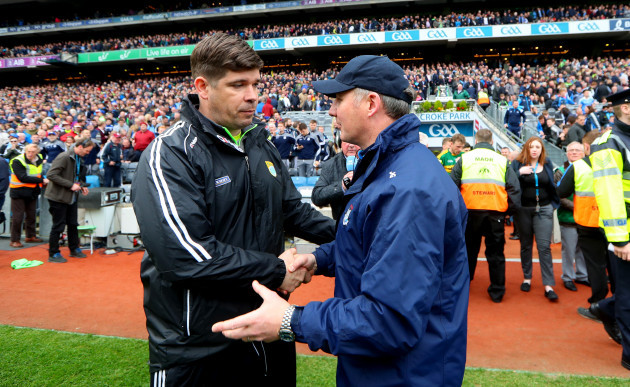YOU’D HAVE TO BE up fierce early in the morning to know what Jim Gavin is up to.
Over the weekend, freshly-minted GAA President Jarlath Burns told us that he had met the architect of the Dublin five in a row triumph four times since October about joining the new football review committee. That’s a lot of keeping mum and staying schtum.
“I have to be honest, I have never met somebody as impressive as he is,” said Burns
“He thinks in a way that nobody I know thinks. His higher-level thinking skills are incredible. I know that he is going to bring all of those skills to the post.”
Burns has picked a veritable catwalk of management and coaching talent and convinced them to spend time in introspection.
His former college and Sigerson winning team mate Malachy O’Rourke. Colm Nally, who has managed the senior team of Burns’ Silverbridge club.
And then James Horan, Colm Collins and Eamonn Fitzmaurice. Yeah, it’s a collection of Hollywood names, but also a good spread of generations, geography and levels of football.
All of them were involved right up until recently. He has gone for men who know what it is to coach the game to the limit that the rules will allow.
Sometimes, that is not a good thing. Most of this group would admit to being bottom-line pragmatists. When they were preparing teams, aesthetics did not form part of their considerations.
Now they are asked to make Gaelic football loved again. Perhaps it never really was.
The jumping-off point for a committee like this is to establish their mission statement. What Gaelic football game do they want?
You can take your pick of Dublin and Mayo games from the previous decade; they were seen as universally popular at the time and in hindsight.
Then, there’s the tactical arm-wrestle. Such as review committee member Eamonn Fitzmaurice overhauling the Kerry style for the 2014 All-Ireland final, after what Donegal had done to Jim Gavin’s Dublin in the semi-final, the day Gavin lost his innocence and remoulded Dublin thereafter.
Surely the tactical battle has its’ place too?
What they can’t ignore is this; sometimes a broadcast of Gaelic football can seem deathly boring. And yet that might not be the sense in person.
Take the 2022 Ulster final for example. Derry and Donegal sniffed each other out all day for openings. Every handle of the ball felt like it was the entire game balancing on a knife-edge.
The tipping point in the game came when the Derry management picked up on Michael Murphy’s calf injury and his movement being restricted in extra-time. They instructed Brendan Rogers to drive straight for Murphy thereafter and tagged on enough scores to win. Incredible in person. Wouldn’t want to watch it back, though.
Gaelic football has become an incredibly complex sport. Coaches now have to able to coach at least half a dozen variations on the goalkeeper kickout. Attacks have to be built in a similar fashion to Spanish soccer with players arranging themselves into a certain formation before they can run plays.
Thereafter, most scores come about by isolating defenders, by loading up players close to goal so that space is available for the 30-metre distance shot, or else the increasingly popular ‘mark’ which is showing signs of being repeatedly coached now.
Laborious build-ups are nobody’s idea of beauty. People may ask why most players do not take risks in the attacking third of the field. A big reason for that is that when contact happens, a referee’s reaction is too great a variable.
It’s a debate that is as old as time. As far back as 2011, Kieran McGeeney proclaimed that a proper definition of the tackle was, “Beyond me now.”
Referee calls will always be disputed in any sport. But soccer, rugby, basketball all have clearly defined tackles.
So too does Gaelic football, but the rule as laid out is not implemented whatsoever.
Rugby players attack as they know exactly what the tackles is and how to ride, avoid, take it or lay the ball off.
Soccer produces a million variations of controversy but defenders at least know they will be in trouble if they launch in or pull and push aggressively.
But if a reborn Gaelic football is to emerge, with more 1 v 1 scenarios, it is a rule that needs clarity.
Two contrasting examples; in this year’s Dr McKenna Cup final, Derry’s Gareth McKinless was involved in some attacking play in the 17th minute. He goes to ground, perhaps aiming to win a free.
At that point, two Donegal defenders get around him. Both have their hands on his back pushing him down. Instead of blowing for a foul on McKinless, referee Conor Curran blows for over-carrying.
Then, to last weekend and the Cork win over Fermanagh. In the first half, Brian O’Driscoll picked up a loose ball and charged straight at three green jerseys.
Referee Anthony Nolan gave a free to O’Driscoll. On another day he might have pointed the opposite way for the crime of charging.
The pass was played inside where Fermanagh’s Che Cullen had minimal contact on Hurley’s back, but the free was whistled for and Hurley converted.
Hurley was clever enough to recognise that he had a whistle-happy referee for the day and he then benefitted from seven converted frees.
Everyone involved in the game; players, coaches and defenders, have no certainty what to expect every week they go out.
What does that lead to?
Teams cutting the percentages. If the opposition get the ball in their defence, the priority for those without possession is to commit a ‘clever’ foul and retreat into a set defensive shape, thereby slowing the game down.
One leading statistical analyst with a county team gives us his verdict; “The situation then emerges where defenders don’t know where they stand, so we get this stand-off group mass defence scenario as they don’t want to concede.
“The frees are leading to a slow game no one likes. Or else you have days you can play totally on or over the edge and your forwards get no protection. So then you avoid contact leading to slow safe play.
“Then, there’s the game when all contact equals a free to the forward which frustrates everyone as its totally different to how previous games have been refereed. Yet that ref might ignore the steps rule and charging.
“Ultimately, it makes coaching, playing and spectating very frustrating at times.”
Fixing Gaelic football? It might be harder to find the table for illegal payments to managers after all.



